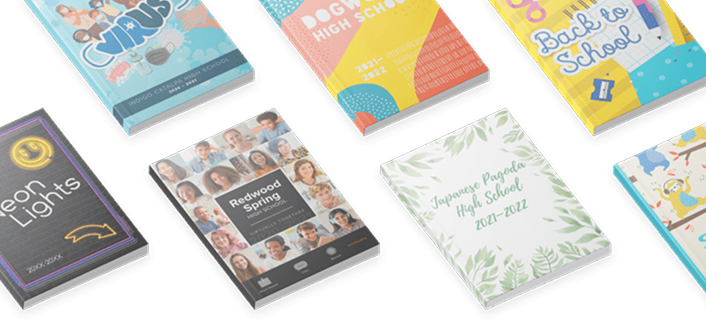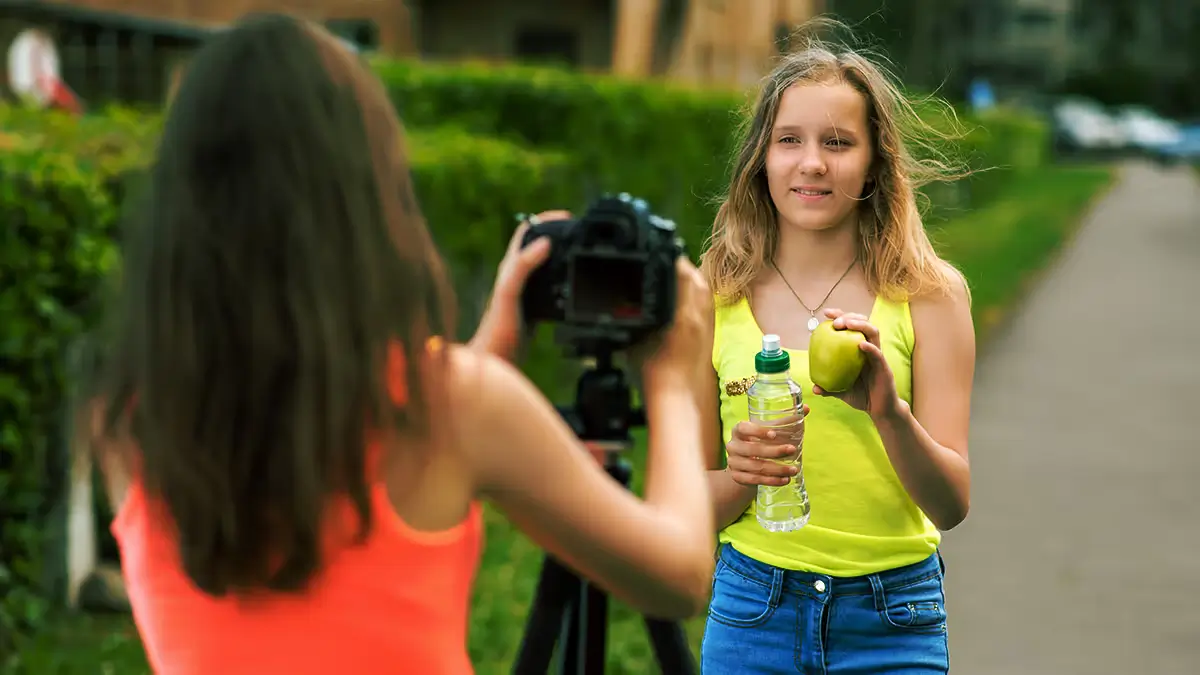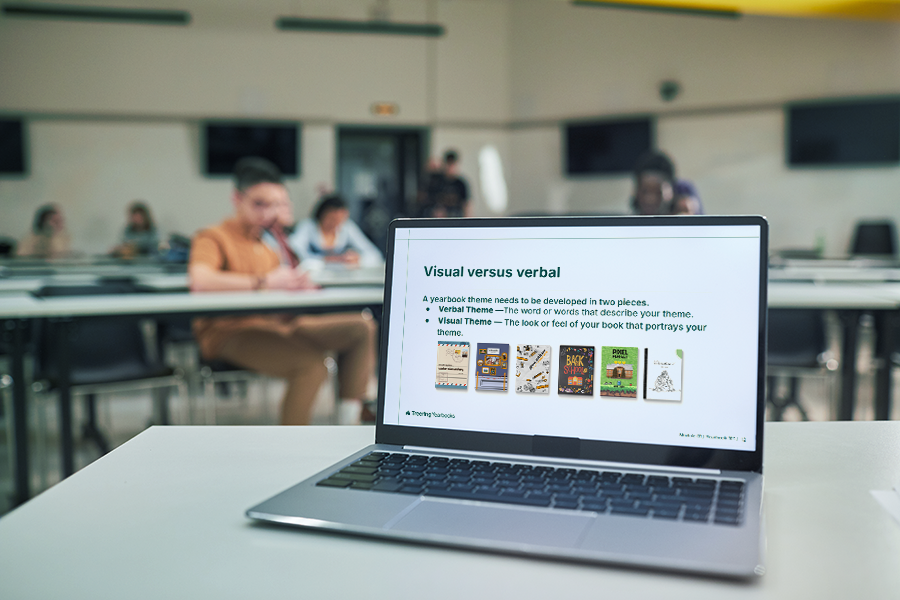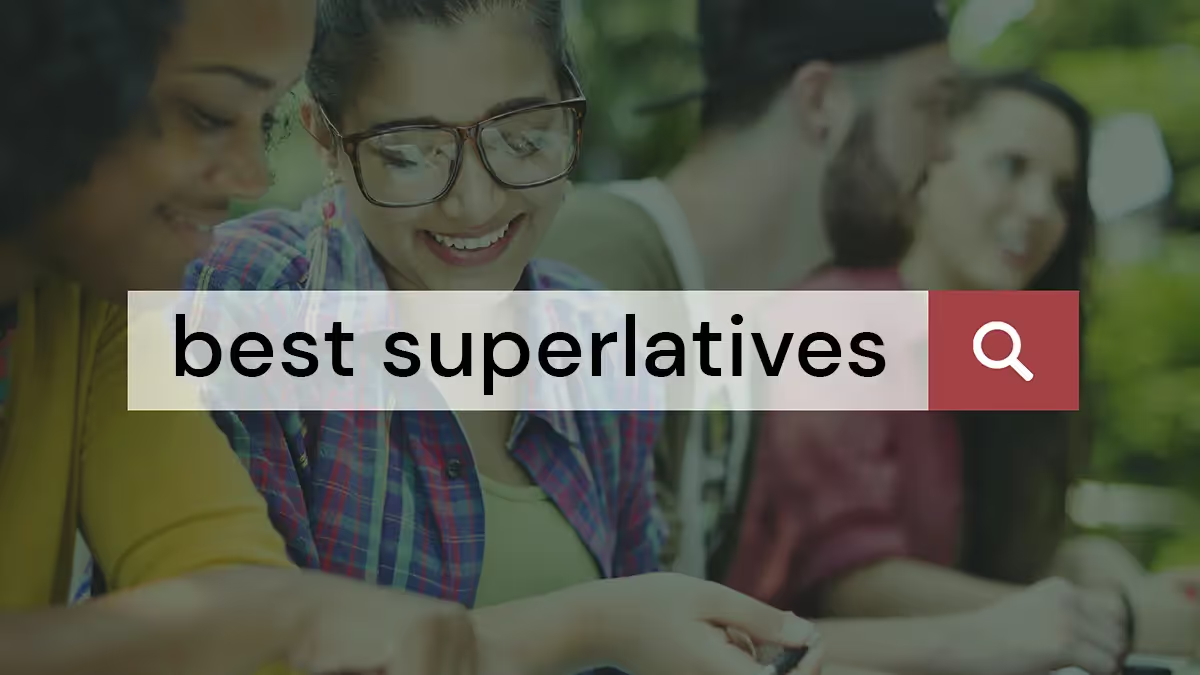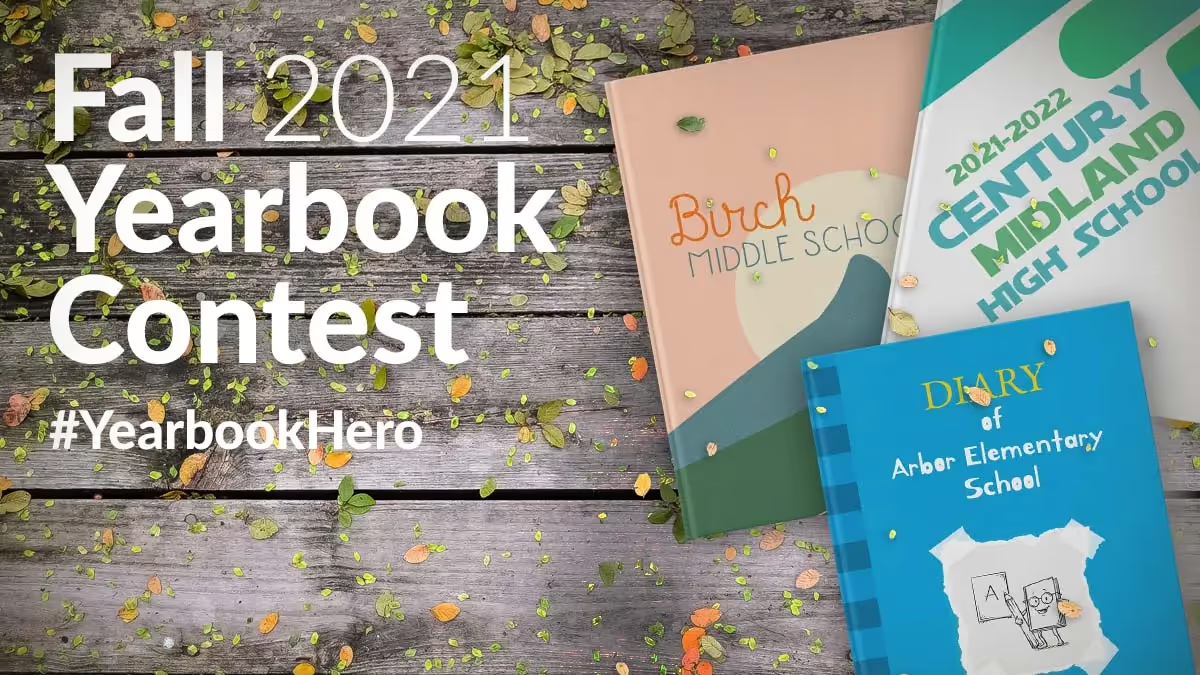Most popular
Subscribe to our blog
Most recent
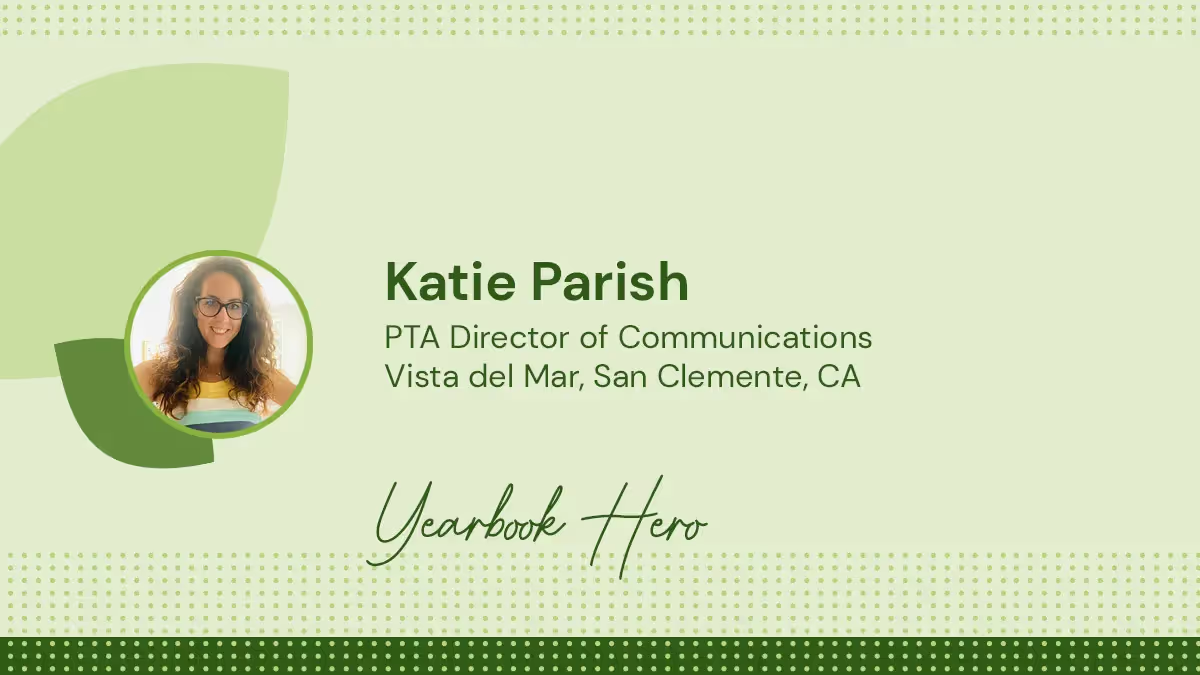
Yearbook hero Katie Parish talks contests, empathy
Not every yearbook coordinator is an Emmy Award winner, but Katie Parish is. The gold hardware on a shelf over her shoulder should be intimidating; after all, Katie knows the value of a quality interview. Two seconds in, and I’m completely disarmed as we talk about volunteering, yearbooking, and being WFH moms.
How did you move from the newsroom to the classroom?
I retired from my television job when my daughter started kindergarten, and I needed something to keep me creative. A lot of people shy away from the PTA, but I really found a wonderful community and was like, “Can I please help make the yearbook?” I started small, just helping with some of the pages.
A lot of people shy away from the PTA, but I really found a wonderful community and was like, “Can I please help make the yearbook?”
Tweet
When we moved schools, I was helping with social media, and the yearbook mom disappeared. I just jumped in and I instantly loved Treering so much. It was so easy to use I totally got it. While I had some previous experience, it just was so much better than the platform we had at my previous school. You have immediate access to photos when parents share them and there are a plethora of graphics and fonts. It’s super simple to lay out the pages and add graphics.
Over 80% of your school community bought yearbooks last year. How did you do it?
My community is a late adoption community: they upload pictures late and they buy books late. I actually leave holes in my spreads because I know I’m gonna be getting more photos second semester.
Over a two-week period, we promoted a class contest. We said whichever class buys the highest percentage of books the week after spring break will win a sweet treat party and the teacher will receive a $25 Target gift card. It’s really important when you have teacher buy-in. The winning class sold 100%, the next one was at 98%.
I love the idea of a marketing contest. How else do you involve the school?
On Halloween, our principal dressed up as Where’s Waldo. I mean, what was I supposed to do? I put him on 13 pages in the book and the kids had to find him. That was just a little interactive thing, and that’s something else that’s so fun about yearbook: it’s organic. During the year, you can build into the book and make align with your community in this specific moment.


We always do a cover contest. Students draw something school related and they have always had to include the name of the school, our key words—Ready, Responsible, and Respectable—and the year. The yearbook committee narrows it down to the top 20, and then the PTA narrows it down a little bit further. The teachers and front office staff, admin, everybody who helps run the school, gets to vote on the winner. I paste all the final covers onto some poster board and have them available to be seen in the office. Then, the winner goes on the front, and the six runners up on the back cover.
Next year is the school’s 20th anniversary, which is the platinum anniversary. So we’re gonna do some silver foil on the cover.
How does your experience as a yearbook coordinator help in your role here at Treering?
Because I work full-time as a Customer Success Manager and I have two kids that I have to run all over creation, and I still volunteer for the PTA, I know what a busy plate looks like. I can help editors prioritize and schedule their yearbook lives, and help them figure out what they should be working on and when so that we’re taking small bites out of the book at a time.
We start with planning out their ladders which translates into an accurate page count and shared photo folder organization. Do you know what’s so great about crowdsourcing? This could be a whole yearbook about your kid, but when you have that option for everyone to contribute, and you make it easy for them to access it, it just gives you so much more diversity in your book of faces.

Happy Holidays from Treering yearbooks
Since 2009, you’ve trusted us to capture and print your priceless memories, and we reflect on this honor every holiday season. In addition to helping schools raise nearly $2 million in the 2022 school year, we printed over 600,000 custom pages in 2022—that’s a lot of joy. Thank you for trusting us with this invaluable task. We wish you all the best this holiday season and we can’t wait to get to work in 2023. Happy holidays!
What to Expect in 2023
- Semi-monthly training through Yearbook Club
- Design contests for editors and parents
- Your memories arriving within three weeks of clicking Print Ready
- New predesigned “About Me,” “Year in Review,” and “Best of…” pages
- Superior support as you design, market, and distribute your best book yet
- Weekly blog articles to provide inspiration and resources – subscribe and have them sent to your email

Staff pictured
Top: Chrissy K. (Customer Success Manager), Jason S. (Customer Success Manager), Jen C. (Customer Success Manager), Niri B. (Customer Success Manager), Brian M. (Director of Engineering) with Titan
Bottom: Melizza T. (Community Advocate Team Supervisor), Codey V. (Community Advocate Team – Quality Assurance), Daneesha B. (Community Advocate Team), Ramona E. (Community Advocate Team), Robelyn O. (Community Advocate Team)

Double your donations 2022
In honor of the season of giving, Treering will match up to five yearbook donations per school account. From November 29 through December 31, one community book donation equals one Treering book donation. Editors can reassign these books to teachers, promoting students, the principal, or students in need.
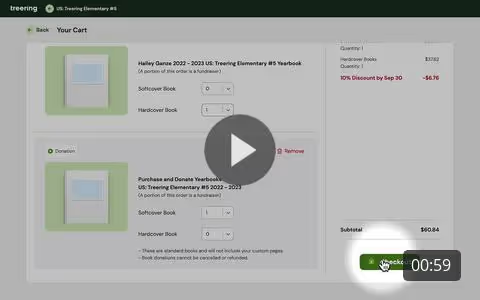
How the Donation Match Works
- Enable the Book Donation option on the dashboard
- Let your campus community know ’tis the season to share the (yearbook) love
- Re-assign the yearbooks so recipients can customize or order non-custom books to hand out
This promotion ends at 11:59 pm PST on December 31, 2022. Matched yearbooks will automatically be added to your account by January 30, 2023.
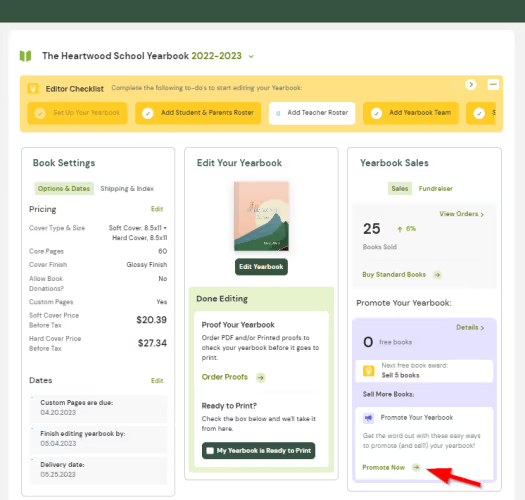
How to Get the Word Out
Think about how your school communicates: social media, TalkingPoints, or email. One of the best ways to share this information with your school community is to use our email notifications which are found in the promote section of the application.
Download and share these images to share on social.
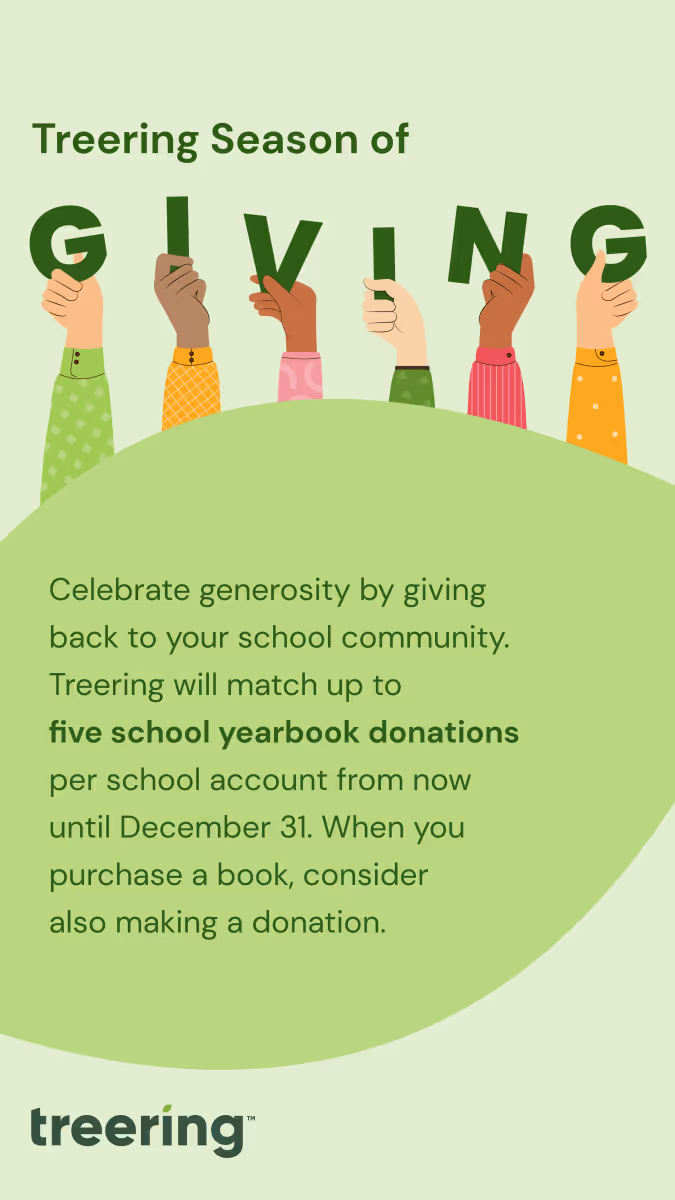
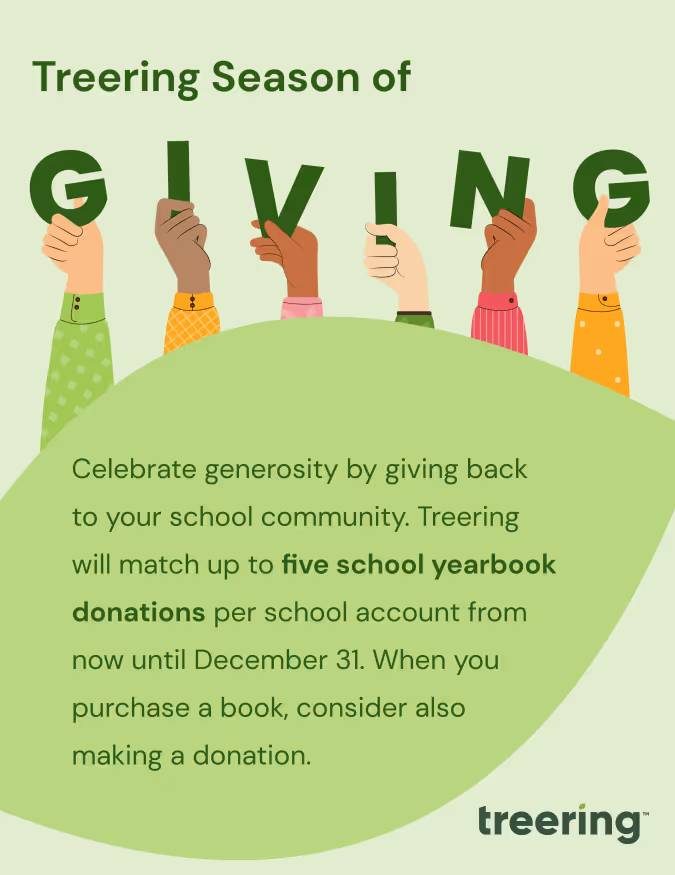
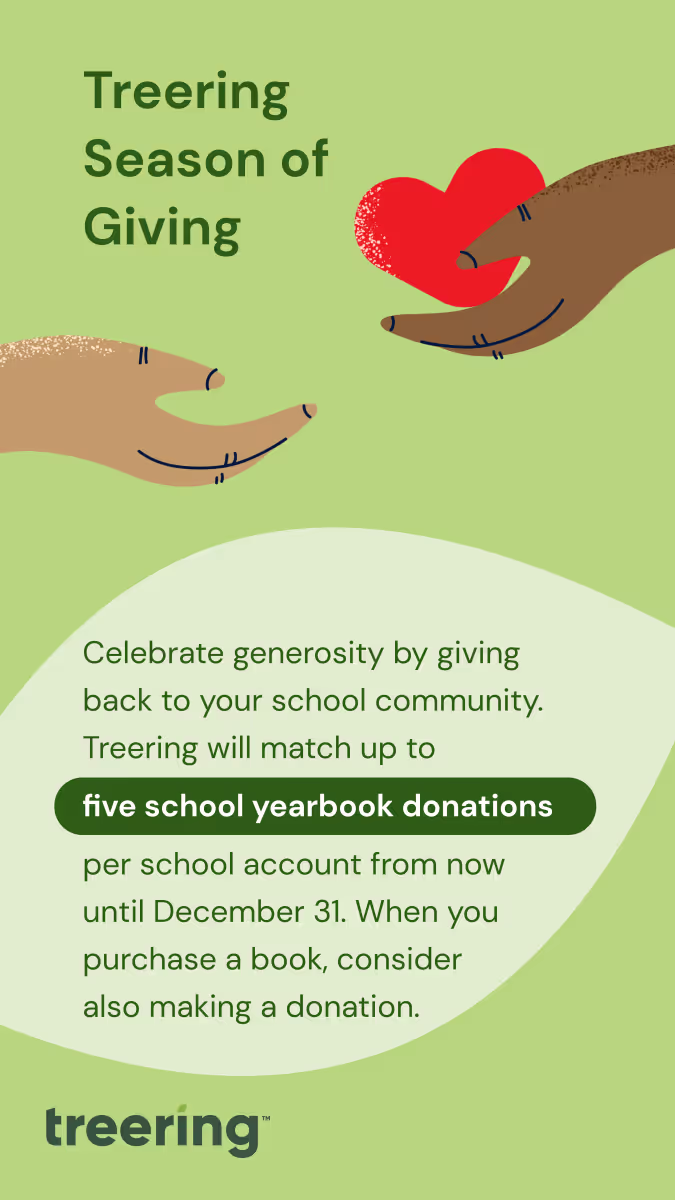
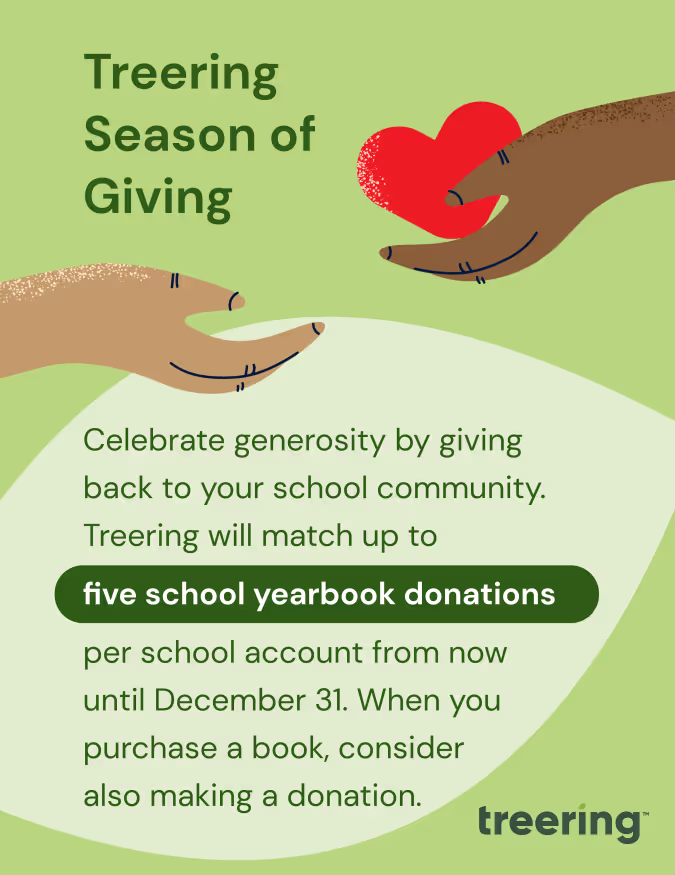
The Fine Print
- Promotion ends at 11:59 pm PST on December 31, 2022.
- Matched yearbooks will automatically be added to your account by January 30, 2023.
- Donations may not be combined with any other promotions.
- Donated yearbooks cannot exist on ship-to-home, invoiced, or PO orders. Credit card or PayPal orders only.
- Ordering donation books will not be available for After Deadline Orders.
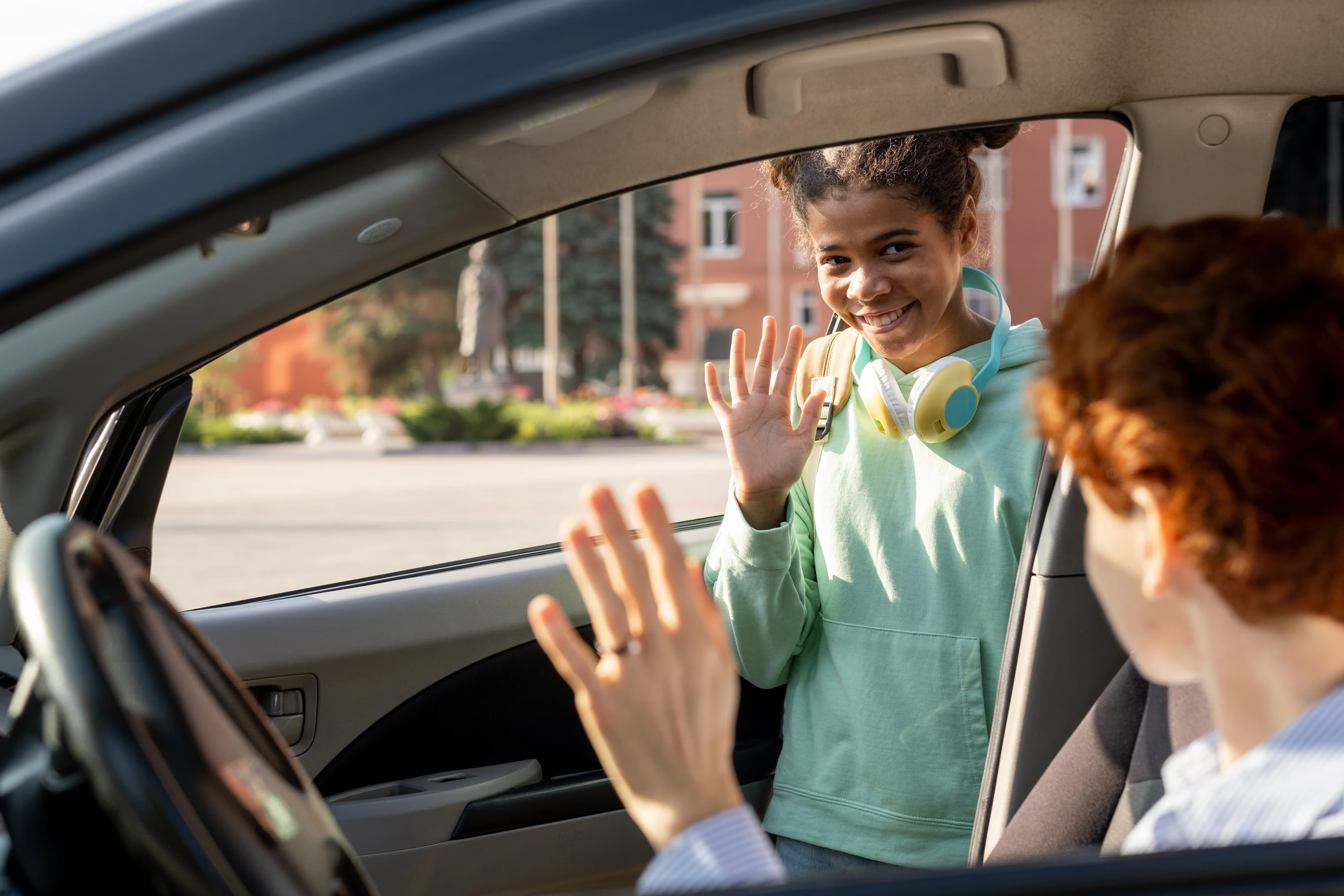
Back-to-school: 5 tips to set your yearbook up for success
Whether you’re excited to get the kids out of the house and into the classroom or kind of dreading the hussle that back-to-school season brings, another year is here! Fear not, we’ve got your yearbook back, cover, custom pages, and everything in between. We’re a yearbook company after all! The first six weeks of school are the best time to set up your yearbook for success.
This might sound overwhelming given you already have to absorb a million new routines, teachers, rules, and other back-to-school rituals, so we’ve simplified it to 5 simple steps to yearbook success this school year.
Set the Yearbook’s Tone: Enthusiasm is Contagious
The first six weeks of school are when everyone is ready to take photos. Welcome back Moma-razzi! It’s a new year, with new friends, new teachers, and new pencils. Bringing this energy into the yearbook can set the tone for the entire year (with rough patches, obviously. We’re all human). The more excited you are to start the book, take and collect photos, the more excited everyone around you will be. Enthusiasm is contagious and engagement is demonstrated by leaders. If the yearbook editor and/or committee is excited, then it’s way more likely everyone else will join in.
Be in the Know: Reboot Your Inner Gossip Girl
Ok so maybe not exactly like the Gossip Girl reboot, but you get the idea. If you’re editing the yearbook, this is the time to know what’s going on. Since most yearbooks show the year in chronological order, be prepared for the first day of school photo opportunities like the car line, opening assembly, and bus drop-offs. You can even reach out to teachers (who are yearbook editors’ best friends) and try to either get inside a couple classrooms for first-day activities or ask them to share all the amazing photos from the day.
You’ll want to know all the back-to-school plans from the school —including the PTA calendar of events. Once you’re in the know, you can work with other parents and/or teachers to take some photos so you don’t feel like you have to be everywhere. If you’re working with students in yearbook creation, make sure you’re in the know about what you’re going to be teaching. Treering has a free curriculum and Adviser Handbook to help.
K.I.S.S.: Keep it Simple Silly
Alright, you’re excited and you know what’s going on the first day of school! You’re almost ready for a fantastic year of yearbooking fun, but we highly recommend getting ready for yearbook by setting up an easy photo system for contributors, whether they are coming from teachers, parents or students. Yearbook can be hard and stressful, so that’s why setting up a system where parents can upload pictures, like a Google Drive, or using a hashtag that’s specific to your school can be beneficial. By using a hashtag, you can tell parents that if they use it, it gives yearbook staff permission to use the photo. This can really take some of the burden off. Your unique hashtag can help you categorize the photos, and, since we’re all on social media these days, possibly get more photos than past years.
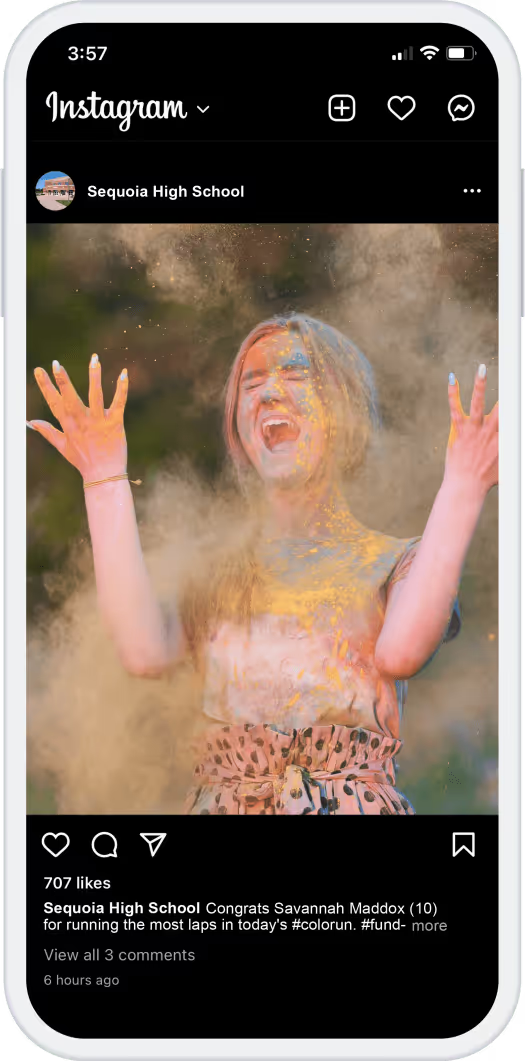
Another easy system to think about: Set up a regular posting cadence on the parent Facebook page, PTA group or the school’s main social media to encourage anyone with great photos to submit to the yearbook. Setting a realistic schedule up front makes it easier to stick to, and contributors get used to hearing from you. Starting a bi-weekly schedule up front instead of reaching out after the first six weeks of school will likely result in more photos. After all, it’s a lot less intimidating to send a couple photos at a time versus the “photo dump” some parents or teachers may have from the first six weeks.
Pay Attention to Your Yearbook Provider: They’re Your Friends
Pay attention to “getting started” emails from your trusty yearbook company friends. The friendly yearbook companies – the ones with excellent customer service, not to name any names – will help you get your yearbook started, you just have to pay attention. Keep an eye out for email blasts to help kick off yearbook creation by walking advisers through back-end aspects of yearbooking. (Yes, it IS a verb!) Depending on what you’re looking for, you can get a mini-course on how to create a yearbook, more advanced design resources, marketing assistance and more. For a #MarketingMoment, brainstorm with your yearbook team on capturing your theme in your group photo. For example, if your theme is an anniversary book, you may want to photograph each member with a past yearbook. Another #MarketingMoment idea: Hype up your last yearbook to the PTA, students and teachers, and sprinkle in all the new plans you have for the first six weeks to build excitement!
Find Your Yearbook Crew: Even if it’s Just One Other Parent
Finding someone that can help you manage shot lists, reach out to teachers and come up with ideas is so important. As you know, and it bears repeating, yearbook is a lot, but it’s also a treasure for kids growing up. That’s what’s most important and what makes getting involved so worth it.
Food-for-thought on where and how to get involved:
Get in with the teachers. Classrooms can become like second homes to students, and their teacher is always there – that’s why they’re your best friend for photos. Ask to bring food and drinks to a staff meeting in exchange for 15 minutes to talk about the yearbook. Give teachers and administrators easy blurbs, talking points and material about the yearbook to include all of their back to school communications. There are some teachers who will not allow us to pull kids for interviews EVER, and some who prefer the first or last 15 minutes of class, so be prepared.
Start a “gotcha!” list. Using the early enrollment roster from the front office, make a card for each student with their name and grade. Once a week or so, go through your coverage report/index and mark off the students you’ve captured. Set a goal to interview or photograph every student at least three times with questions of the day or activities they’re involved in.
Celebrate! Set easy wins to give yourself, your crew, the PTA or school a reason to celebrate. Oh, you received 50 photos from the first day? BAM! Let’s go get dinner. This classroom submitted the most photos after the first six weeks of school? BAM! Reward that teacher and students with a little prize. Even small milestones deserve a celebration, and each celebration will motivate more people to participate.
Have questions on how to start building a better yearbook? Check out our Help Center for customer support.

Free yearbook syllabus template & course description tips
t doesn’t matter if you’re teaching World Literature, AP Chemistry, or (you guessed it) a yearbook course, creating a syllabus can be a bit of a time suck.
There’s a fine line between including enough information to answer students’ questions and providing the kids in your class with an intimidating tome they’ll never glance at again. This presents a special sort of problem for yearbook courses, since the endgame isn’t a term paper or oral presentation or lab but, rather, a physical product.
If you’re a veteran yearbook teacher, you’ve probably got your syllabus ready to rock; a few tweaks here and there to reflect date changes and updated requirements and you’re all set. If you’re new to the game, though, where on Earth do you begin?
Why, right here. (Of course…)
Inside this post, we’ll share a free yearbook syllabus template with you and walk you through the most important components to include. That way, you’ll know exactly what your students need for a semester (or year) of success.
Use the information we’ve laid out in this post to fill in the particulars and your students will be ready to get to work on the best book your school’s ever seen.

Yearbook Syllabus Component #1: Course Description
We’ll start out with something simple: The course description, simply put, exists to explain to students exactly why they’ve stumbled into your classroom.
In your yearbook syllabus, that description should provide a quick snapshot of your course. Students should have already seen the course description when they decided to sign up during course selection, but including it here gives both participants and their parent/guardian an idea of what to expect without having to dig through your syllabus.
In the philosophy and goals sections that come after the course description, you’ll elaborate on the why and how of your yearbook class. Here, however, your goals is to simply impart what the course is.
If you structure your class in such a way that all students try their hand at everything, mention that here; if your class tends to run like a newspaper or publishing house, in which students identify a specialty and work towards their individual craft, that’s important to note, too.
Yearbook Syllabus Component #2: Course Philosophy
Your course philosophy is another important piece of your yearbook syllabus. While you may have included an instructional philosophy on syllabi for other classes you’ve taught, your approach towards creating one for this class in particular requires an additional layer of thought.
Why, you might ask?
Because you and your students are creating something that their peers will fawn over for days and then cherish for decades.
Your yearbook course philosophy should provide answers to the following questions:
- Why are students here?
- How will they accomplish the monumental task set before them?
- What will learning look like in this course?
The key here is brevity. While you could ramble across a dozen pages explaining the intricacies that underpin every assignment the majority of your students would either ignore them or flee at the very sight. Keep it simple.
Yearbook Syllabus Component #3: Course Objectives
The final introductory component of your syllabus, before we get into the technical stuff, is your list of course objectives.
The trick here is formatting: Think back to your own educational experiences, the path you took to becoming a teacher. Remember those pedagogy classes you had to take before standing in front of a classroom? We sure do. (Yup; some of us here at Treering were education majors.) And the thing that’s stuck with us best is the scientific-sounding SWBAT, or “Students will be able to” format in which our professors insisted we frame course goals.
By creating between five and ten goals, laid out in a numbered or bulleted list, you make it clear exactly what your students will walk away with. You know, other than a yearbook.
Since yearbook classes have such potential for variance on a student-by-student basis (a graphic designer, a journalist, and a copy editor will have vastly different, albeit equally important, semesters) there are a couple of ways to approach goal creation. You might choose to make your goals broad enough to capture the experiences all members of your course will have. You could use each goal to highlight what you expect from photographers, writers, designers, and so forth.
Spend some time thinking about which method will work best in the context of your course, and don’t be afraid to modify goals (using student feedback) once your yearbook is published.
Yearbook Syllabus Component #4: Resources
While it’s highly unlikely that you’ll be leaning on a clunky textbook to impart yearbook wisdom on your students, there will undoubtedly be a set of materials and resources that are necessary for both student success and yearbook creation.
Again, there will be variance here based on the roles each student assumes on your yearbook staff. It might be helpful to divide your “Resources” section up into sections based on these roles (for example, a journalist isn’t going to need a camera, but they will need a notebook and pen and perhaps a voice recorder to ensure accurate quotes and a record of useful details that will bring the retelling of a school event to life).
If your school provides students with laptops—or if you’ll be using a computer lab—be sure to spell out exactly which pieces of software they’ll be required to use in order to perform within their given role. If your school doesn’t possess some of the fancier, more expensive resources, like professional design software or professional-model cameras, get creative by discovering free browser-based tools and leveraging the power of the smartphones nearly every kid has in their pockets to create great content.
(Note: don’t forget to include a note on lost or damaged school property!)
Yearbook Syllabus Component #5: Student Evaluation
Ah, grades… every student’s favorite subject.
Spelling out exactly how your students will be assessed is a really important part of establishing expectations for the upcoming semester. While you might not want to come right out and say “to get an A, you need to do…”, it is important to break down the factors that contribute to student evaluation. If participation and attendance account for 20% of a student’s grade, mention that; if attending out-of-class events for the purposes of content creation is necessary in order to earn an A, make that clear, too.
You’ll notice in the syllabus template that the “Student Evaluation” section has been left blank; that’s because every school uses a different set of standards by which to measure student success. If your school uses a rubric-based grading system, include an example, detailing the various levels at which students are to be evaluated (and what success should look like for each one).
Yearbook Syllabus Component #6: Course Rules & Requirements
Laying out exactly what’s expected of students in terms of behavior is foundational to their academic progress and your yearbook’s success.
If you tend to run an open classroom, spell that out; if students can come and go as they please, which may very well be the case given the nature of a yearbook course, tell them. Conversely, if you’re looking to foster a more structured environment, one with more instruction than content generation, you might want to explain the role of participation and importance of active listening.
While it may seem redundant to spell out behavioral expectations, it can’t hurt to hammer home how students should act in class. A yearbook course teeters somewhere between a traditional academic environment and a publishing house; respect for ideas and the structure you establish is paramount. This goes without saying, but don’t forget to highlight the importance of academic honesty. It’s one thing to plagiarize a book report; it’s another thing entirely to steal from uncredited source material and then publish it in a yearbook.
Yearbook Syllabus Component #7: Attendance Policy
While “come to class” should seem obvious, there’s always some smart alec who will consider using “it didn’t say so in the syllabus” to weasel his or her way out of showing up.
It’s likely that your school has its own attendance policy; if this is the case, simply copy, paste, and call it a day. In the event it’s up to you to decide on an attendance policy, carefully weigh how many tardy arrivals and absences you’re willing to afford your students.
There’s one specific area in which an attendance policy for your yearbook course will differ from that of calculus or chemistry or any other subject for that matter: out of class time is necessary. Students will need to spend time at school events or working on completing your book as deadlines approach; be sure to spell this expectation out in your syllabus.
Yearbook Syllabus Component #8: Course Calendar
Your course calendar is the scaffold for the semester, the year, and your yearbook production cycle
While it may very well be subject to change based on the pace at which your students learn and subsequently complete the work, you’ll want to make sure that your course calendar includes:
- Weekly goals and subjects covered in class
- Important publishing-related suspenses
- School events that will require coverage
- Required after-school workdays
Yearbook Syllabus Component #9: Parent / Guardian Acknowledgement
This final component of your yearbook course is an affirmation that both your students and the people at home are on the same page as you. While this is standard for a syllabus at the high school level, it’s extra important that parents/guardians understand the importance of the out-of-school component of your course.

Ready to create your own yearbook course syllabus? Does the thought of staring at a blinking cursor on an empty word document incite procrastination or fear (or both!)? Thankfully, you don’t need to start from scratch. Download our free template and use everything you just learned to jumpstart your yearbook course syllabus creation.

7 high school yearbook themes that are ready to use
Retro yearbook theme packages offer a nostalgic twist to your yearbook, bringing back the charm of past eras. They can transport you to different times and evoke a sense of nostalgia. Nostalgia in design is powerful. Fueled by shared experiences and moments with others, it reinforces feelings of connectedness and belonging. Embracing these themes can give your yearbook a bridge between past and present for your collective memories.
What Is Retro Graphic Design?
Retro yearbook themes use elements that are typically associated with non-contemporary looks. From vintage illustrations to classic color palettes, we’ll break down each decade in design below. Consider this the Eras Tour of Treering.
The Treering yearbook theme highlights Y2K aesthetic with futuristic elements and nods to retro design styles from the 1990s and earlier.
Could a OS-inspired theme be more early 2000s?
This retro futurism yearbook theme looks especially turn of the century when done in silver foil.
2000s and Y2K Aesthetic
Since retro typically refers to events 20 years past, we begin with the advent of internet-influenced design. Remember when we stockpiled groceries and awaited the digital doomsday? A yearbook influenced by the turn of the millennium is characterized by a distinct blend of futuristic and traditional elements layered:
- High-energy color palettes, metallics, and iridescent shades
- Digital distortions and drop shadows
- Abstract and geometric shapes
The 1990s embraced an eclectic mix of styles, often blending influences from different decades and cultures.
A pop culture-inspired theme is one way to add a retro look to your yearbook.
1990s Design for your Yearbook
With the rise of technology, artists began to explore digital mediums to create interactive and multimedia artworks. The themes of the nineties centered around identity. In pop culture, it was the era of Friends and TGIF, and design often incorporated references to these cultural phenomena. With desktop publishing becoming more available to consumers, emerging designers pushed the boundaries of traditional design rules to use asymmetrical arrangements and overlapping elements.

A Throwback Theme From the 1980s
Famously, the bold colors and gestural brushwork of Neo-Expressionism dominate eighties design. It’s also the period that saw the rise of digital technology, a pop culture explosion, and a distinct visual style that continues to be recognized and celebrated during spirit weeks across the nation.
It’s not a 1980s-inspired retro yearbook theme if it doesn’t include some of these:
- Neon colors
- Geometric shapes, preferably layered with a glow effect
- Airbrushing and gradients
- Maximalism and excess
- 8- or 16-bit art

The 1970s’ Influence on Design
Graphic artists of the 1970s made ideas and concepts the focus over traditional artistic mediums. Artists often challenged the notion of art as a physical object. The color palette of the time featured earthy and warm tones, including browns, oranges, yellows, and olive greens. These colors were reflective of the era’s emphasis on nature and a more relaxed, organic aesthetic. While disco culture inspired illustrations with a sense of movement and rhythm, typography also showed some personality with exaggerated serifs, curves, and swashes.
Consider your distribution party for your retro-themed yearbook a piece of performance art.
The 1960s embraced bold and vibrant color palettes, including electric blues, neon pinks, and acid greens.
The retro yearbook theme inspired by the London Underground emphasizes clean lines, simplicity, and a focus on essential elements.
Customize the colors of Geometric Bold’s shapes in the page editor.
Taking it Way Back to the 1960s
This was the decade of contrasts. Pop art and its bright colors celebrated mass culture, consumerism, and everyday objects at the start of the 1960s. Remember the soup cans? Later, major socio-political shifts impacted design and this period became synonymous with breaking away from the norm.
A yearbook with a counter-culture theme might want to incorporate retro elements inspired by
- Mod influences from the Beatles and the subsequent British invasion
- Op art: those wavy lines and swirls you associate with 1969’s iconic music festival, Woodstock
- Eclectic or maximalist approaches to convey a contrast
Future Implications
Consider this: your grandkids will produce a retro yearbook theme using key design trends from the 2020s: eco-conscious and minimalistic with sensory-friendly and accessible design.

The one-stop yearbook rubric shop: grading tools for design & copywriting
A yearbook grading rubric is the perfect way for teachers to give students the grades they deserve and the feedback they need to make a better yearbook.
Heck, even if you’re working with a bunch of volunteers and want to formalize your process around feedback, a yearbook grading rubric is pretty much the way to go: it’s the most holistic way for you, the adviser, to provide critical feedback to your staff. For the younger students you’re working with, this will lead to growth; by their senior year, these kids will be ready to skip right over college and head straight to Sterling Cooper.
To help give your grading and feedback game a jump start, we’ve developed two free yearbook grading rubric templates that you can use for your class or club. One’s focused on yearbook copy, the other’s focused on yearbook design.
Before we jump into the templates themselves, though, we’ll break down why we’ve structured the rubrics the way we did and what you can gain from using them. So, read on.
Anatomy of a Yearbook Rubric
If you’re a teacher, you’re probably familiar with rubrics. (In fact, if you’re a teacher who uses rubrics, you’re probably more familiar with them than we are; you’re also probably able to skip this section.)
If you don’t know rubrics, though, this section here is a short crash-course for you. I’ll be helpful for understanding the templates we’ve put together for you.
Generally speaking (and specifically speaking in terms of our yearbook rubric templates), a rubric consists of three core areas: Scale, criterion, and performance level descriptions. Let’s break each of them down.
Scale
The scale represents the total number of points available in each category as well as the aggregated total (the final grade). Instead of just applying numerical values to each level of performance, pair each possible point on the scale with a narrative equivalent. For example, if the maximum number of points that can be earned in a given criterion is 4, then 4 = Exceeds Expectations. Conversely, in the same scenario, a 1 would be equivalent to “Does Not Meet Expectations.” You can play around with the actual wording in the scale you choose.
Criterion
Where the scale represents the number of points, criterion are the categories by which a piece of student work is assessed. They can be altered , as long as you can clearly distinguish between the levels of accomplishment on your chosen scale. For example, if we’re assessing a student’s ability to write a headline for a page, there should be a way to objectively measure what an “A” headline looks like versus what a “C” headline looks like. If there isn’t, reconsider including it as a criterion (perhaps it can be combined with one or more other facets of the page instead).
Performance Level Descriptions
A rubric is broken into quadrants. In the examples we’ve provided, the vertical headers represent the criterion and the horizontal headers represent the scale. The points of intersection are the Performance Level Descriptions, or PLDs. These are the characteristics that make up a grade. Try to use highly-specific language so that students are clear on what separates good work from work that will truly blow you away.
If your PLDs are fully fleshed out, we suggest giving your students your yearbook rubrics in advance. This gives them an idea of what they need to do in order to earn the grade of their choosing, which can positively impact the quality of their work.
Miscellany
Don’t forget to include:
- The student’s name
- Page numbers, or spread, being assessed
- Total points
With that quick review out of the way, let’s dive into the actual yearbook rubrics.
Yearbook Rubric For Grading Copywriting
When it comes to yearbook copy, striking a balance between originality and uniformity is key: Too rigid and your yearbook won’t engage. Too much creativity expression, and it could end up looking like an anthology of erasure poems.
In the downloadable template we’ve created, the categories for assessing yearbook writing are: headlines and subheads, body copy, captions, adherence to style guide, and originality. Let’s take a closer look:
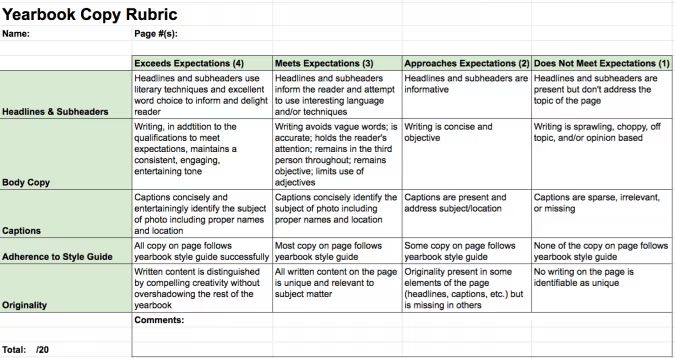
Get the Treering Yearbook Copy Grading Rubric here.
By assessing the writing on each page, you achieve two things. First, you give your students a tangible grade for their hard work. Second, you can vet the copy on every page of the book, which gives you an idea as to how everything fits together tonally and whether the book as a whole adheres to your established style guide.
Yearbook Rubric For Grading Design
While assessing writing is straightforward, design can feel subjective; we can’t all be trained art critics, creative directors or teachers, after all.
In the downloadable template we’ve created, the categories for assessing yearbook page design elements are: typography, color, photographs, adherence to style guide, and cohesiveness. Let’s take a closer look:

Get the Treering Yearbook Design Grading Rubric here.
As a result, you might be tempted to break the elements of design into a handful of granular rubrics (one for photography, another for layout: you get the picture). While there’s nothing wrong with doing this, developing a rubric that takes everything into account is a better approach.
Here’s why:
Ensuring that the individual elements work in concert is as important as the quality of those elements in their own right. For those for those classes where the principles of design are just beginning to be explored, this is important. Focus on the whole first, then the specifics later.
If you’re teaching a yearbook course and need to grade your staff on their work, rubrics are the perfect way to do it. If your staff is composed of after-school volunteers who won’t be graded on their work, rubrics like the one’s we’ve included above can be a fantastic way to provide actionable feedback and ensure high quality design and copy on every page.

Why your yearbook writing needs the inverted pyramid
The easiest way to hook your reader is to use a yearbook writing technique that’s used by the pros: Put the most important stuff first.
You and your yearbook team have limited time to capture a reader’s attention—and, perhaps more importantly, limited space to tell your story—so you should be focused on hitting them with the big stuff right out of the gate.
In journalism, this writing technique is known as the inverted pyramid. In military and government briefs, it’s known as BLUF (Bottom Line Up Front).
Because the yearbook is journalistic in nature, we’ll be sticking with the term “inverted pyramid” throughout this post. But know this: Whatever you call it, the technique is an effective means of communication. And it’s one your team can use when looking to improve its yearbook writing.
Inside this post, we’ll walk you through what the inverted pyramid looks like and how you can break it down into manageable chunks.
What The Inverted Pyramid Looks Like
When it comes right down to it, the organization of your yearbook writing should look like this:
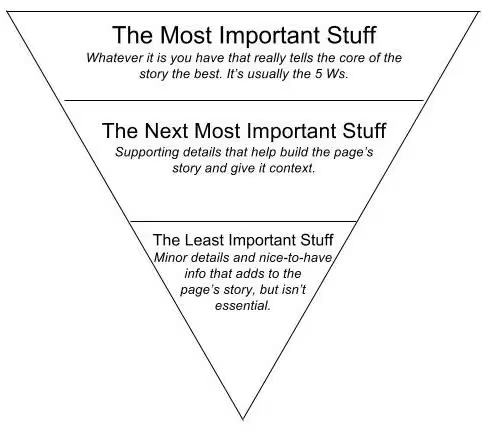
That’s an inverted pyramid.
It’s a three-tiered writing diagram that forces the most important stuff to the very top and the remainder of the story’s details into the two remaining tiers.
How to Use The Inverted Pyramid in Your Yearbook Writing
This approach to yearbook writing might sound obvious (or maybe even boring), but plenty of student journalists will try to tell a story in chronological order. Help them avoid that by showing them this diagram.
Put The Most Important Stuff First
Your opening lines, or the lead, as it’s often known, should immediately state what’s special about the article. What was different about the event this year as opposed to last year? What makes this story noteworthy?
The lead should cover most of the five Ws: Who, What, When, Where and Why. These elements provide the biggest, most important pieces of information, and should be introduced early in your article.
The more interesting the news, the more reader will want the details. You’re not writing a mystery novel, so don’t try to tease your audience with page-turning suspense. You’ve got a limited time to capture their attention, so hit them with the big stuff right out of the gate.
Put The Next-Most Important Stuff Second
Now that the reader is invested in the story, this is a great space to share more about the event or achievement, and the students that were involved.
After reading the headline and the lead, readers will get the basics of what happened. The middle section is your opportunity to tell more of a story. You can also expand a bit more on the how.
You can do this in a few ways, but some of the most proven tactics include:
- Relying on first-hand accounts. Relying on interviews with students and participants can help you paint a picture of what an event felt like to those who experienced it. Quotes, in particular, can help evoke emotion, which is a strong way to keep readers engaged.
- Including background details. If you can continue to build on your 5 Ws, all the better. Background details, like the time left on the clock when the basketball team scored the championship-winning basket or the number of hours it took the stagehands to build the set for the school play, helps propel a story along and give the reader a deeper understanding of what happened and why you’re writing about it.
- Using pull-quotes. Really great quotes can do more than just evoke emotion. They can also be used to break up text and add some design elements to your page or spread. Think of a pull-quote as another entry point for the reader.
Just as in the overall structure of the inverted pyramid, the middle section should begin with the most important details, and cascade down to the less essential stuff. There aren’t clear breaks between beginning, middle, and end sections, so you don’t have to worry about where one section ends and the next begins.
Put The Least-Most Important Stuff Last
If you’ve really captured your reader’s attention, they’re going to be hungry for every little bit of information they can get. (You know the binge TV watcher who seeks out fan forums online? Or the Belieber who knows lyrics to the songs that didn’t make Justin Bieber’s album? That’s the type of reader who stays until the end.)
The more you can attract an audience with the big hits, the more you can interest them in the details.
Details that would otherwise be left out belong at the end. They might be interesting, but if you need to cut them for space, it’s no big deal. Of course, you’ll want to leave the readers satisfied, so if you can finish with any kind of pithy or clever line, that will make them more likely to read your next article from start to finish. A retrospective or forward-looking quote from a student is also a nice way to draw each piece to a close.
Chances are your pages won’t be filled with text, but you’ll want to share what you’ve got in a way that makes sense. If you follow this simple formula, you’ll not only be able to highlight the year’s most memorable moments, you’ll also develop a clear and valuable method of yearbook writing from top to bottom—and that’s the point.

